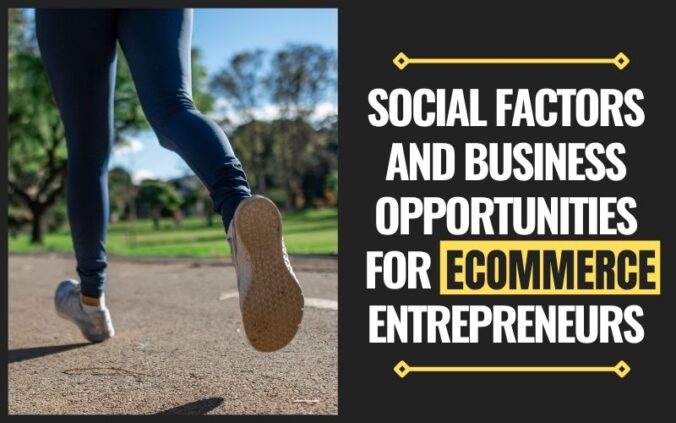I recently purchased a Fitbit watch, and I fell in love with it. I now spend more time tracking my heart rate and sleep patterns and finding ways to “improve” my scores. Maybe I am a fitness nerd, but I find all this data and fancy reports addicting. But why did I buy this watch in the first place? In my last two articles, I talked about how politics and inflation affect business and Ecommerce strategies. Today, I want to discuss the impact of societal factors and give a few examples of opportunities they have created over the last few years.
The impact of demographics on business
Part of societal factors is demographics. Demographic data includes age, race, ethnicity, gender, marital status, income, education, and employment. It affects all aspects of a country’s economy, and as explained in my book, it is imperative for a business to understand its target demographics. But, it is equally important to understand the current trends to predict future changes in the market and customer expectations.
For example, according to Reuters: “Currently, 16.5% of the U.S. population of 328 million people, 54 million are over the age of 65, the latest census shows. By 2030, that number will rise to 74 million. The number of people over the age of 85, who generally need the most care, is growing even faster.”
We all know that the population in developed countries is aging. At first, this might sound like bad news for an Ecommerce entrepreneur. Most research shows that older customers prefer shopping at retail stores. They prefer seeing the physical product at the store, don’t feel comfortable enough with technology, or don’t trust online payments. However, millennials, including myself, and generation Z, grew up with the internet and are the future older people. Once we reach our sixties and seventies, we’ll be more likely to shop online. Now, we don’t know what new technology will be available in thirty years, and maybe our way of shopping will be outdated, but that is another question.
The aging of the population also helps us predict shifts in the size of industries. If the population keeps aging, we can expect the market for walkers and wheelchairs to grow while the market for snowboards will shrink.
Another example of a trend closely related to demographics is people moving away from big cities to smaller towns or rural areas, thanks to the remote work opportunities. Remote workers are often well educated, with a higher-than-average income. They spend less time in traffic commuting to work and more time enjoying the world outdoors away from big cities. This new trend created a wide variety of opportunities. Remote workers now spend more time in their homes and have invested in nicer offices and furniture. The Covid-19 pandemic and people moving away from big cities are two of the reasons the outdoor and camping market grew so much between 2019 and 2022. RV and camping equipment sales are now much higher than in the past decade. Like other demographic factors, education and income have a large impact on customers’ behavior. There are many data and studies available on people’s habits per income tier.
New trends mean new opportunities
Trends come and go, and business owners need to be aware of what is happening. The sooner you are certain about a trend, the better (it isn’t easy to tell if something will be a short fade or a long-term trend).
Businesses made billions taking advantage (and sometimes making questionable claims) of the customers now being more attracted to green, friendly, and local products. Not only are companies selling locally produced or sustainable products, but they are also advertising their environmentally-friendly practices. Sustainable practices are especially relevant for businesses selling their products online. Shipping products requires sturdy packaging to ensure that products don’t arrive damaged at their destination. More and more companies are turning to recycled and/or biodegradable packing materials and are getting rid of plastic wrap and packing peanuts in favor of cardboard. Other more innovative companies are attempting to innovate and offer reusable shipping boxes to online retailers. Companies are also trying to reduce their carbon footprint of transportation, for example, by using EV vehicles for last-mile deliveries. Optimizing the returns process is also a priority, not only by ensuring customer satisfaction, so they don’t return products, but also by not throwing away all returned products and finding ways to repair, recycle, or repackage them.
Another good example of a relatively recent trend here to stay is the popularity of “healthy” products. We keep hearing about the obesity epidemic, but the wellness market is estimated at around $1.5 trillion, with an annual growth of 5% to 10%. From fitness watches to nutritional supplements, people are spending more and more money on themselves (I must admit, I personally contribute to the growth of this industry!). According to a recent McKinsey study, 23% of respondents plan to spend more on wellness products next year. This trend is driven by a bunch of factors, such as incorporating influencers, having a more stressful life, or wanting to lower the risk of diseases.
Being aware of new consumers, demographic trends, and their implications is essential for businesses of any size. Customers’ habits are constantly shifting, and new trends often equal massive opportunities for entrepreneurs.
https://www.cbre.com/insights/articles/omnichannel-how-does-online-spending-vary-by-generation

